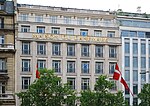TV6 (French TV channel)

TV6 was a French private and free national television channel dedicated to music and youth, created on March 1, 1986. One year later to the day, it was also the first to die live in the history of French television, on Saturday, February 28, 1987, at midnight, five years before La Cinq (a clear stop for political reasons following the parliamentary elections in the spring of 1986, which were lost by the majority and won by the opposition represented by Jacques Chirac). The new government (the first cohabiting government) had decided to undo the audiovisual achievements and projects of its predecessors (and political opponents) and in particular to reallocate the owner of the sixth channel to Métropole Télévision, thus leaving TV6 very little time to build its programs and demonstrate its audience progress. A few hours after TV6's definitive disappearance, on Sunday, March 1, 1987, M6 broadcast its first live broadcasts. Despite a short broadcast period, TV6 has left its mark on the television genre with personalities such as Jean-Luc Delarue, Childéric Muller and Alain Maneval and a new tone, inventing the "free antenna" and music TV. TV6 has left a strong imprint on a whole generation.
Excerpt from the Wikipedia article TV6 (French TV channel) (License: CC BY-SA 3.0, Authors, Images).TV6 (French TV channel)
Avenue des Champs-Élysées, Paris 8th Arrondissement of Paris (Paris)
Geographical coordinates (GPS) Address Nearby Places Show on map
Geographical coordinates (GPS)
| Latitude | Longitude |
|---|---|
| N 48.872926111111 ° | E 2.29741 ° |
Address
Avenue des Champs-Élysées 129
75008 Paris, 8th Arrondissement of Paris (Paris)
Ile-de-France, France
Open on Google Maps











